Army Art Posters and Prints
ARMY ART OF WORLD WAR I
CMH Pub 70-52;
Not Available through GPO sales.
16 full-color 11" X 15 1/2" reproductions printed in cooperation with the Smithsonian Institution, highlighing the work of eight Army Artists assigned to France during the war years. Set includes a booklet that provides brief descriptions of the artists' life and work. Individual prints may not be requested.
* View this publication online.
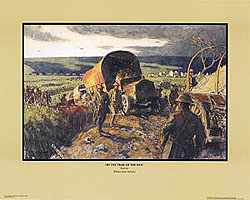
ON THE TRAIL OF THE HUN, ST. MIHIEL DRIVE
by William James Aylward
In this painting Aylward provides a glimpse of the seemingly endless truck and wagon trains that followed the advancing armies to keep them supplied with the materiel of modern warfare.
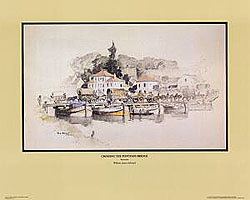
CROSSING THE PONTOON BRIDGE, CHATEAU-THIERRY
by William James Aylward
The fledgling truck making its way across the bridge in the midst of a convoy of horses, wagons, and artillery captures the introduction of the internal combustion engine to war.
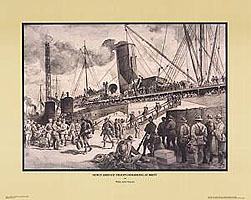
NEWLY ARRIVED TROOPS DEBARKING AT BREST
by Walter Jack Duncan
Duncan's skill as a detailed illustrator is evident in this depiction of the arrival of one of the many ships that transported the 2 million "doughboys" who eventually reached Europe.
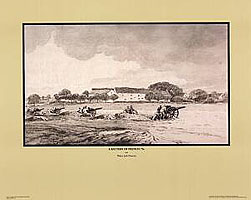
A BATTERY OF FRENCH 75s SHELLING THE GERMANS ON THE RIDGE TO THE LEFT OF CHATEAU-THIERRY
by Walter Jack Duncan
This scene of an American field artillery battery armed with the famous French 75-mm. guns provided Duncan the opportunity to include some details of the French countryside.
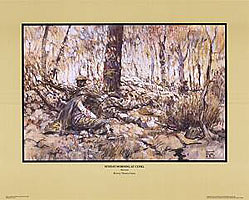
SUNDAY MORNING AT CUNEL
by Harvey Thomas Dunn
This impressionistic view of the aftermath of battle shows American infantrymen who have just overrun an enemy position, as evidenced by the abandoned German helmet in the foreground.
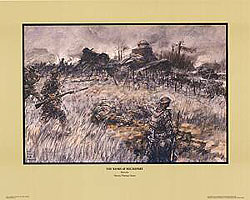
THE TANKS AT SEICHEPREY
by Harvey Thomas Dunn
In all probability Dunn made the preliminary sketches for this piece using his unique artist's box as he accompanied the tanks and infantry into the barbed wire-infested no-man's-land.
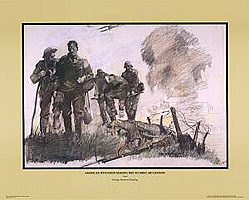
AMERICAN WOUNDED MAKING WAY TO FIRST AID STATION IN THE VILLAGE OF MARNE DURING GERMAN ATTACK
by George Matthews Harding
Here Harding shows the ever-present human toll of war along with two of the innovations of the Great War, the airplane and barbed wire.
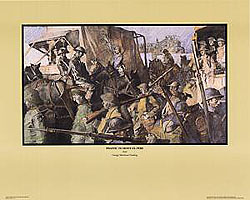
TRAFFIC TO MONT-ST. PERE
by George Matthews Harding
This jammed road provides a vivid reminder of the chaos and confusion that surrounds modern war even in rear areas.
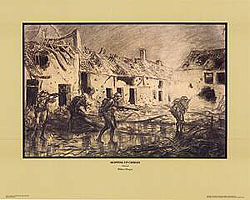
MOPPING UP CIERGES, 1918
by Wallace Morgan
American infantry are shown here finishing the job of rooting out the enemy after artillery has virtually destroyed the town.
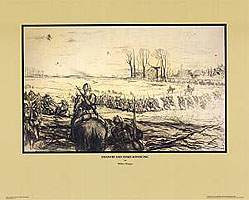
INFANTRY AND TANKS ADVANCING ON FIELD, JULY 10, 1918
by Wallace Morgan
Morgan captures a turning point in the history of warfare as both tanks, the weapon of the future, and horse, which would never again play any significant role, move intermingled with columns of infantry, the ever-present mainstay of war.
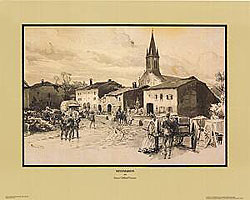
NEUFMAISON: A TYPICAL VILLAGE OF THE LORRAINE FRONT IN WHICH THE AMERICAN TROOPS ARE BILLETED
by Ernest Clifford Peixotto
This scene captures the peaceful atmosphere of a small French town in a rear area away from the fighting.
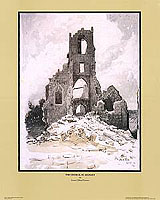
THE CHURCH, ST. AIGNANT
by Ernest Clifford Peixotto
Peixotto's image of church ruins is representative of the impact the war's massive destruction made on a number of the artists.
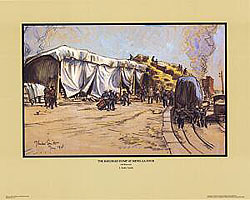
THE RAILHEAD DUMP AT MENIL-LA-TOUR
by J. Andre Smith
Loading hay onto railroad cars for transport to the front was only part of the huge logistical effort required to feed the thousands of animals used in the war.
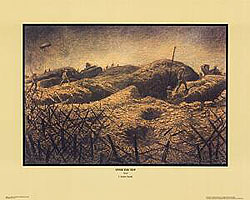
OVER THE TOP
by J. Andre Smith
The mood set by Smith, the shrouded images of men and machines advancing through an artillery ravaged no-man's-land, reflects the somber reality of war.
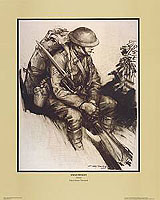
INFANTRYMAN
by Harry Everett Townsend
This portrait captures the subdued confidence--of winning the war and of getting back home--that the American soldier carried with him into battle.
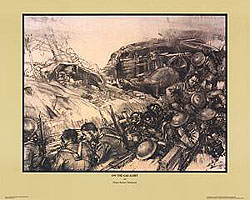
ON THE GAS ALERT
by Harry Everett Townsend
Townsend portrays the narrow line between life and death in the trenches for both men and animals as gas became a weapon of war.